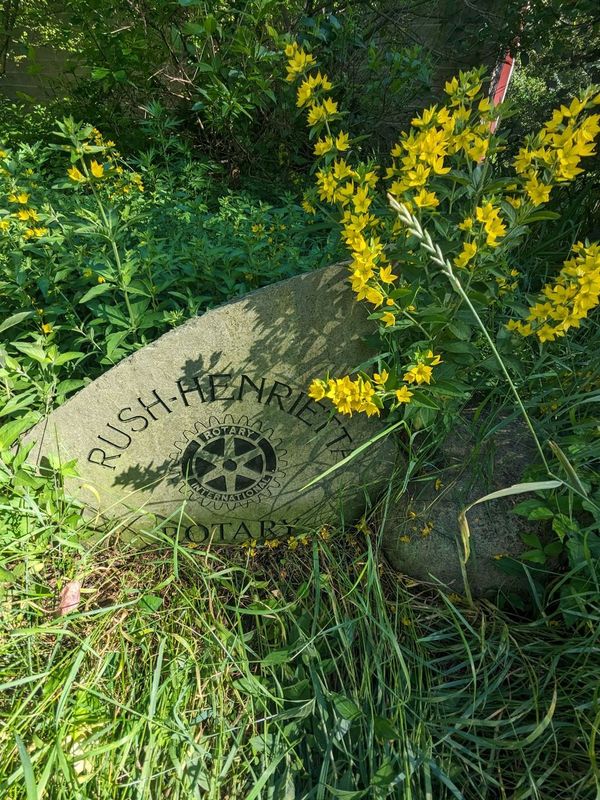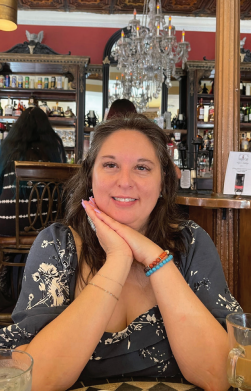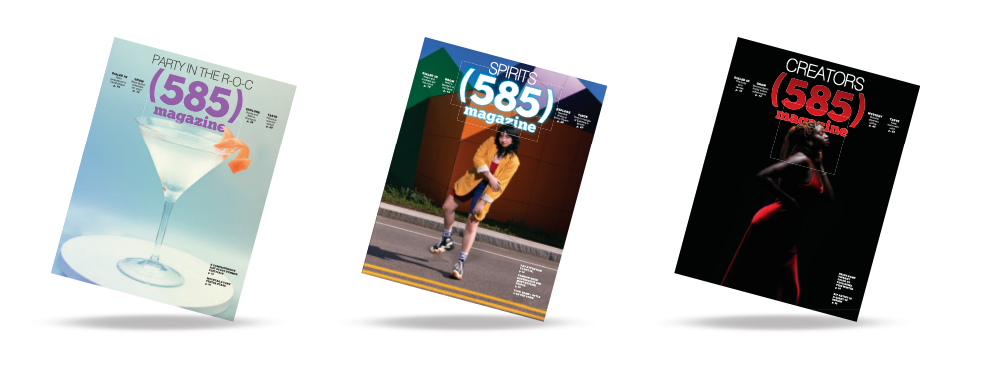
Around the garden
BUFFALO AND ERIE COUNTY BOTANICAL GARDENS INTRODUCES “PLAYSPACE” On March 26 the Buffalo and Erie County Botanical Gardens opened Playspace. Playspace is an interactive exhibit

BUFFALO AND ERIE COUNTY BOTANICAL GARDENS INTRODUCES “PLAYSPACE” On March 26 the Buffalo and Erie County Botanical Gardens opened Playspace. Playspace is an interactive exhibit

SPONSORED LISTINGS May 17: 15th Annual Garden Faire, 9 a.m.–4 p.m., the village square: Central Ave. and Main St., Silver Creek. This event will feature

In April 2023 I went to Koufonisia, two small, beautiful islands in the Cyclades of Greece. The weather was wonderful, with a daily high in

The First Dandelion by Walt Whitman Simple and fresh and fair from winter’s close emerging, As if no artifice of fashion, business, politics, had ever

If you ever put up a birdfeeder, you might find that soon enough you are getting more than just birds. Squirrels are very good at

This fresh salad is the perfect light lunch on a nice spring day. Pair it with grilled chicken or shrimp and a loaf of crusty

Dress up a plain flower pot with an easy pour-paint method. The most time-consuming part is waiting for the paint to dry. This is a

The task of creating a dedicated vegetable garden can feel overwhelming—carving out a large chunk of your yard to create the perfect growing space isn’t

I think native bushes (aka shrubs) are the most underrated of landscaping possibilities. Because of their size, they are relatively easy to handle for planting

The 100-year-old maple that once stood in my front yard had to be removed recently. It just hurts my heart to think about it, but


BUFFALO AND ERIE COUNTY BOTANICAL GARDENS INTRODUCES “PLAYSPACE”
On March 26 the Buffalo and Erie County Botanical Gardens opened Playspace. Playspace is an interactive exhibit where kids and families can learn about the important connections between people, plants, and pollinators.
Playspace features interactive and educational signage, imaginative play stations, hands-on activities, busy boards, and other fun ways to get curious about the world we live in. Activities such as “Flip and Find” and “Count the Critters” allow kids to move oversized “pollen” between flowers, create their own blooms with fun shapes, and stack honeycomb blocks. By becoming the pollinator, kids learn about pollination and how bees live and produce honey. The exhibit also features “Honey Hut” market, where kids can pretend to buy and sell honey and other bee products and see how important pollinators are to humans.
However, Playspace is far from all that’s in store for Buffalo and Erie County Botanical Gardens. Many more changes to the conservatory and campus are expected as part of its expansion and renovation project. One addition that was recently announced is the Butterfly Experience, another part of the larger thematic initiative to emphasize the importance of pollinators.
Parents and children alike can enjoy the wonders of the flora from around the world found at the Botanical Gardens thanks to the addition of attractions like Playspace. The exhibit features tables and seating for activities, as well as stroller and wagon parking. The exhibit is open from 10 a.m.–4 p.m. during Botanical Gardens operation days. Admission is included with a Botanical Gardens ticket. buffalogardens.com/thingsto-do/playspace

CELEBRATE THE SUMMER SOLSTICE WITH KIRBY’S FARM MARKET
“When the sun comes back to Western New York, we need to celebrate! The Summer Solstice marks the start of the summer harvest season, when so many different homegrown fruits and vegetables will be available in our area - it’s a great time to get together!” says Stacey Kirby, of Kirby’s Farm Market. And celebrate is exactly what Kirby’s will do to welcome the start of summer. On Saturday, June 1 from 1 to 4 p.m., Kirby’s Farm Market will be holding its Summer Solstice Celebration. This will include a field walk at 1 p.m., an “All About Pollinators” presentation with Monroe County’s Master Gardeners at 2 p.m., the planting of Kirby’s Community Garden at 2:30 p.m., and a cyanotype prints demonstration at 3 p.m.
Kirby says that the event is particularly important because it emphasizes the roles that pollinators play. “People understand how important pollinators are, but many people don’t know what they can do at home to help. This is a chance to learn simple things we can do to support these tiny but essential parts of our world. Plus, it’s always great to have a reason to get outside!” For more info visit kirbysfm.com.

CAMP HACCAMO NEEDS GREEN THUMBS
Camp Haccamo has been providing fun and community for youth and adults with disabilities since its opening in 1956. With a campus equipped with a fully accessible climbing wall, pool, fishing pond, splash park, nature center and more, Camp Haccamo strips away barriers individuals may experience at other summer camp programs. But even more than that, Haccamo is a place filled with joy and acceptance. The camp’s board chair Neal Gorman says, “My favorite aspect of volunteering with Camp Haccamo is the real-life tangible impact we have. It’s about continuing the legacy of the founders who, sixty-nine years ago, sought to bring joy and make a difference. We are still doing that today. Being part of a team that creates such positive experiences is incredibly rewarding. I love being able to contribute to that.”
The campgrounds have needed maintenance and revamping for some time now. Camp director Dolly Kujawa says, “A beautiful and well-maintained landscape is a benefit to everyone viewing the landscape. The Haccamo Gardens are located inside the railroad tracks of the Haccamo train. It has been challenging to keep up with the maintenance of the gardens, but it is important to have them maintained so the campers, camping staff, and visitors to the camp can enjoy them and appreciate them as they ride around on the train.”
The campus has a dedicated maintenance crew that works diligently to keep the grounds clean and in prime working condition for all the camps that run throughout the year. However, Haccamo staff needs more help to be able to continue to do the amazing work they do. Camp coordinator Logan Everhart suggests, “I think a new improvement would be a legit flower bed. There are flower beds at camp but only at the entrance when campers get dropped off. If campers were able to see more flowers and different plants in designated areas it may encourage them to want to pursue that field outside of camp.”
If you are interested in helping Camp Haccamo with revamping the gardens, visit camphaccamo.org.
Hannah Frazier is a communications and media studies major with a minor in English at Nazareth University.
This article originally appeared in the May/June 2025 issue of Upstate Gardeners’ Journal.
Upstate Gardener's Journal

SPONSORED LISTINGS
May 17: 15th Annual Garden Faire, 9 a.m.–4 p.m., the village square: Central Ave. and Main St., Silver Creek. This event will feature a variety of craft and plant vendors, along with food available for purchase. Raffles will be available at each of the vendor booths, with tickets for purchase at the gazebo. Sponsored by the Silver Creek Hanover Garden Club.
May 31: FLNPS/Cornell Botanic Garden Plant Sale, 10 a.m.–2 p.m. 397 Forest Home Drive, Ithaca. The sale will feature native plant species from FLNPS members’ gardens and propagation efforts as well as assorted annuals, herbs, and perennials from the Cornell Botanic Gardens. All are welcome; you need not be a member of either FLNPS or the Cornell Botanic Gardens to purchase plants. A portion of the proceeds will be used to support FLNPS in its mission to educate members and the public about the benefits of using native plant species in our landscapes and to promote that activity through lectures, walks, workshops and plant sales.
BUFFALO
REGULAR CLUB MEETINGS
African Violet & Gesneriad Society of WNY meets the third Tuesday of the month, September–August, at 7 p.m., Greenfield Health & Rehab Facility, 5949 Broadway, Lancaster. [email protected].
Alden Garden Club meets the second Wednesday of the month (except July and August) at 7 p.m., Alden Community Center, West Main St., Alden. New members and guests welcome. Plant sale each May. 716-937-7924.
Amana Garden Club meets the second Wednesday of the month (except January) at Ebenezer United Church of Christ, 630 Main St., West Seneca. Visitors welcome. 716-844-8543, [email protected].
Amherst Garden Club meets the fourth Wednesday of the month (except December, March, July, and August) at 10 a.m., St. John’s Lutheran Church, Main St., Williamsville. New members and guests welcome. 716-836-5397.
Bowmansville Garden Club meets the first Monday of the month (except June, July, August, and December) at 7 p.m., Bowmansville Fire Hall, 36 Main St., Bowmansville. New members and guests welcome. For more information, 716-361-8325.
Buffalo Area Daylily Society. East Aurora Senior Center, 101 King St., East Aurora. The society is a friendly group who get together to enjoy daylilies. Plant Sales in August. Open gardens, June–August. Facebook.
Buffalo Bonsai Society meets every second Saturday at 1 p.m. at ECC North Campus, STEM Bldg., 6205 Main St., Williamsville, NY 14221. Picnic/Auction; 9/14, (Rochester, NY) Penjing Bonsai; 10/12, Mark Arpag; 11/9, Suiseki with Sean Smith. buffalobonsaisociety.com.
East Aurora Garden Club meets at noon on the second Monday of each month, except January. The clubs meets at Nativity Lutheran Church, 970 E. Main St., East Aurora, NY (just west of the 400 Expressway exit). The club’s objective is to stimulate, create interest, and promote education on horticulture, the art of gardening, flower arranging, and environmental conservation; and to promote the beautification of surrounding areas. For more information about the club or membership call 716- 912-1589.
Federated Garden Clubs NYS–District 8. Nancy Kalieta is the director; [email protected]. gardenclubsofwny.com.
Forest Stream Garden Club meets the third Thursday of the month (September–May) at 7 p.m., Presbyterian Village, 214 Village Park Dr., Williamsville and other locations. Summer garden teas and tours available. Ongoing projects include beautification of the Williamsville Meeting House, garden therapy at a local nursing home, youth gardening, and Victorian Christmas decorating. [email protected].
Friends of Kenan Herb Club meets the third Monday of the month at 2 p.m. at the Taylor Theater. New members are always welcome. kenancenter.org/herb-club.
Garden Club of the Tonawanda meets the third Thursday of the month at 6:30 p.m., Tonawanda City Hall, Community Room. Facebook.
Garden Friends of Clarence meets the second Wednesday of the month at 7 p.m., September– June, Town Park Clubhouse, 10405 Main St., Clarence. [email protected].
Gardens Buffalo Niagara open gardens on Thursdays and Fridays in July starts Thursday, July 11. Explore the beauty of gardens spread out in Erie and Niagara counties. Visit gardensbuffaloniagara.com/ open-gardens-buffalo for more details and location information.
Hamburg Garden Club meets the second Wednesday of each month (except July and August) at 10 a.m. at the VFW Post 1419, 2985 Lakeview Rd, Hamburg, NY. Events include a June plant sale and July and August field trips. New members and guests are welcome. Contact [email protected].
Kenmore Garden Club meets the second Tuesday of the month (except July, August, and December) at 10 a.m., Kenmore United Methodist Church, 32 Landers Rd., Kenmore. Activities include guest speakers, floral designs, and community service. New members and guests are welcome. [email protected].
Ken-Sheriton Garden Club meets the second Tuesday of the month (except January) at 7 p.m., St. Mark’s Lutheran Church, 576 Delaware Rd. Kenmore. Monthly programs, artistic design, and horticulture displays. New members and guests welcome. 716- 833-8799, [email protected].
Lancaster Garden Club meets the second Wednesday of the month (except January, July, and August) at 7 p.m., St. John Lutheran Church, 55 Pleasant Ave., Lancaster. All are welcome. Facebook.
Lewiston Garden Club meets the fourth Monday of the month. See website for meeting information, lewistongardenfest.com/garden-club.html or contact at PO Box 32, Lewiston, NY 14092.
Niagara Frontier Botanical Society meets the second Tuesday of the month September through May at 7:30 p.m. (except April) at the Harlem Rd. Community Center, 4255 Harlem Rd., Amherst. Entrance is on the north side of the building. Meetings are open to the public.
Niagara Frontier Orchid Society (NFOS) meets the first Tuesday following the first Sunday (dates sometimes vary due to holidays, etc.), September– June, Botanical Gardens, 2655 South Park Ave., Buffalo. niagarafrontierorchids.org.
Orchard Park Garden Club meets the first Thursday of the month (except July and December) at 11:30 a.m. at St. John’s Lutheran Church, 4536 South Buffalo St., Orchard Park. Contact Diana Szczepanski at 716- 674-8970 for membership information. Guests are always welcome.
Ransomville Garden Club meets the third Wednesday or Saturday of the month at 5:45 p.m., Ransomville Community Library, 3733 Ransomville Rd., Ransomville. Meetings are open to all. Activities include community gardening projects, educational presentations, and June plant sale. bbonnie2313@ gmail.com.
Silver Creek-Hanover Garden Club meets the second Saturday of the month at 11 a.m., Silver Creek Senior Center, 1823 Lake Rd. (Rte. 5), Silver Creek. [email protected]
South Towns Gardeners meets the second Friday of the month (except January) at 9:30 a.m., West Seneca Senior Center. New members welcome.
Springville Concord Garden Club meets the second Monday of the month at 1:30 p.m. at the Concord Senior Center, 40 Commerce Dr., Springville, NY 14141. Meetings feature guest speakers on a variety of gardening and related topics. Annual July Garden Walk. Guests are welcome.
Town and Country Garden Club of LeRoy meets the second Wednesday of the month (except February) at 6:30 p.m., First Presbyterian Church, 7 Clay St., LeRoy 14482. Prospective members and guests are welcome. Contact: [email protected]. Facebook: facebook.com/GardenClubLeRoyNY.
Town and Country Garden Club of Williamsville generally meets the second Thursday of the month from 2–4 p.m. at the Ransom Oaks Community Club House, 101 Ransom Oaks Dr., East Amherst. Some meetings are held off site for garden tours and special events. The club maintains a garden at the Clearfield Library, 770 Hopkins Rd. Membership brochures with program information are available in the library. For information, contact [email protected].
Tropical Fish Society of Erie County meets the third Tuesday of the month at 7:30 p.m., Lake Erie Italian Club, 3200 South Park Ave., Lackawanna, NY 14218. tropical-fish-club-of-erie-county.com
Western New York Herb Study Group meets the second Wednesday of the month at 7 p.m., Buffalo and Erie County Botanical Gardens, 2655 South Park Ave., Buffalo. Facebook.
Western New York Honey Producers, Inc. Cornell Cooperative Extension of Erie County, 21 South Grove St., East Aurora. wnyhpa.org.
Western New York Hosta Society. The WNYHS was formed to encourage members to appreciate hostas and to provide them with access to quality new varieties. The group meets three times a year at the East Aurora Senior Center, 101 King St., East Aurora NY 14052. wnyhosta.com.
Western New York Hosta Society Breakfast Meetings are friendly get-togethers the first Saturday (winter months only) at 10 a.m., Forestview Restaurant, Depew, wnyhosta.com.
Western New York Iris Society meets at the Julia B Reinstein Library, 1030 Losson Rd., Cheektowaga, NY at 1:30 p.m. on the first Sunday of each month.
Western New York Rose Society meets the third Wednesday of each month at 7 p.m. St. Stephens-Bethlehem United Church of Christ, 750 Wehrle Dr., Williamsville. Check the Facebook page or website for meeting content, wnyrosesociety.net.
Youngstown Garden Club meets the second Wednesday of every month at 7 p.m., First Presbyterian Church, 100 Church St., Youngstown. Facebook.
CLASSES / EVENTS
FREQUENT HOSTS
BECBG: Buffalo & Erie County Botanical Gardens, 2655 South Park Ave., Buffalo, NY 14218. 716/827-1584; buffalogardens.com.
REIN: Reinstein Woods Nature Preserve, 93 Honorine Drive, Depew, NY 14043. 716-683- 5959; reinsteinwoods.org.
F- Indicates activities especially appropriate for children and families.
May 10: Amphibians: Masters of Two Worlds, 10:30 a.m. Wrap up Amphibians Week 2025 with an indoor presentation on the important role amphibians play in the ecosystem, followed by a guided walk to spot some amphibians at Reinstein Woods. Registration required; call 716-683-5959. REIN
May 10: Basic Tree Identification, 10 a.m., Draves Arboretum. Register at Dravesarboretum.org.
May 12: Full Moon Walk, 8:30 p.m. This stroll is a springtime full moon walk where walkers learn about the flower moon and explore what the animals of Reinstein Woods are up to at night. Registration required; call 716-683-5959. REIN
May 14: Senior Stroll, 10 a.m. Experience nature at your own pace and enjoy a leisurely hour-long guided walk through the woods. For adults only. Registration required; call 716-683-5959. REIN
May 17: 15th Annual Garden Faire, 9 a.m.–4 p.m., Silver Creek Village Park. This event will feature a variety of craft and plant vendors, along with food available for purchase. Raffles will be available at each of the vendor booths, with tickets for purchase at the gazebo. Sponsored by the Silver Creek Hanover Garden Club.
May 17: Dare to Repair Café, 10 a.m.–1 p.m. Bring broken items (lamps, small appliances, etc.) to the repair café and have volunteer “fixers” try to repair the items for free. This event is designed to reduce waste going into landfills and build a sense of community. Register for the event at the Tool Library. org/daretorepair/ or for more information, call 716- 683-5959. REIN
May 17: Woods Walk: Nature Guide’s Choice, 11 a.m. This is guided nature walk through the woods. No registration required. REIN
May 20: Nature at Night, 8 p.m. Listen to the nocturnal sounds of spring on this evening wetland walk. Registration required; call 716-683-5959. REIN
S May 23–24: Master Gardener Plant Sale, 8:30 –3 p.m. Enjoy a huge selection of quality plants from the gardens of Master Gardeners Brought to you by the Cornell Cooperative Extension. Event goes until 3 p.m. on Friday, and 2 p.m. on Saturday. First Presbyterian Church, 1 Symphony Cir. Buffalo. 716- 652-5400
May 24: Forget-Me-Not Walk, 10 a.m. Celebrate Memorial Day weekend with a nature walk highlighting spring wildflowers. Registration required; call 716-683-5959. REIN
May 31: Fabulous Fungi, 11 a.m. A mushroom enthusiast will lead this beginner-friendly walk as they attempt to identify as many mushrooms as possible. For ages 12 and older. Registration required; call 716-683-5959. REIN
T May 31: WNY Iris Society, 1–4 p.m. Iris and perennial show, all grown by members. Open to the public. Julia B Reinstein Library, 1030 Losson Rd., Cheektowaga, NY.
S June 7: Hamburg Garden Club Annual Perennial Plant Sale, 7:30 a.m.–1 p.m. Perennials from member gardens and previously loved gardening items will be available. Hamburg Farmers Market, Hamburg Moose Lodge, 523 Church St. Hamburg.
June 21–22: Lewiston GardenFest, 10 a.m.–5 p.m. This annual event features vendors, speakers, open gardens, and a container garden contest. Visit lewistongardenfest.com or email [email protected] for more information.
S June 28–29: Garden Art Sale, 10 a.m.–4 p.m. Gardens Buffalo Niagara invites passionate artisans and vendors to showcase their creativity at the fifteenth annual Garden Art Sale in partnership with the Buffalo and Erie County Botanical Gardens. The Garden Art Sale, a beloved summer tradition, offers a prime platform for artisans to share their gardenand nature-themed creations with an ever-growing and enthusiastic gardening community. Event ends at 4 p.m. on Saturday and 3 p.m. on Sunday. BECBG
SAVE THE DATE...
July 12: Open House, 1:30 p.m. Draves Arboretum annual open house tour. Register at dravesarboretum.org.
F July 12: Sixth Annual Butterfly Release, 8 a.m.–1 p.m. Gardens Buffalo hosts conservation groups with butterfly release by Eastern Monarch Butterfly Farm. BECBG
S July 12–13: Hamburg Garden Club Sale, 10 a.m.–4 p.m. The Hamburg Garden Club will have a tent selling garden items. Memorial Park, Union & Lake St., Hamburg, NY.
T July 18–19: Ken-Ton Garden Tour Night Lights, 8:30.–11 p.m. The Ken-Ton Garden Tour is one of the most anticipated events of the summer in the Ken-Ton community, an annual celebration of color that showcases the hard work and dedication of local gardeners. For more information, visit kentongardentour.com.
T July 19–20: Ken-Ton Garden Tour Day Tour, 10 a.m.–4 p.m. See description above.
T July 19–20: Eastside Garden Walk, 10 a.m.–4 p.m. fee and self-guided tours. Maps are available at the Juneteenth parade, downtown Buffalo public libraries, and online at eastsidegardenwalk.com.
T July 26–27: Garden Walk Buffalo, 10 a.m.–4 p.m. There will be more than 300 gardens on the annual tour. The tour is free and self-guided. Visit Gardenwalkbuffalo.com for more info.
ITHACA
REGULAR CLUB MEETINGS
Adirondack Chapter, North American Rock Garden Society (ACNARGS) Meetings are open to all. Check the current newsletter on the website for meeting location: acnargs.org or Facebook.com/acnargs.
Auraca Herbarists, an herb study group, usually meets the second Tuesday of the month at noon, Cornell Botanic Gardens, Ithaca. Brown bag lunch at noon followed by the program. and herb of the month. Field trips during the growing season. All are welcome. Contact: Pat Curran, [email protected].
Elmira Garden Club meets the first Thursday of the month, April–December, at 6 p.m., 426 Fulton St., Elmira. Annual plant sale, workshops, monthly meetings, local garden tours and community gardening services. Karen Coletta, 607-731-8320, Facebook.
Finger Lakes Native Plant Society meetings are usually on the third Tuesday of the month September to May. They are an organization dedicated to promoting the appreciation of native flora and hold free public field trips, free indoor programs, and provide members a newsletter, seed exchange, native plant sale, and a December celebration of native plants. flnps.org, [email protected].
Windsor NY Garden Group meets the second and fourth Tuesdays of the month at 10 a.m., members’ homes or Windsor Community House, 107 Main St., Windsor. windsorgardengroup.suerambo.com.
CLASSES/EVENTS
May 10: Spring Ephemeral Walk, 10–11:30 a.m. Walkers will discover the different species they can find in the woods each spring. The trail is one mile long and mostly flat but with uneven ground, please wear sturdy shoes and dress for weather. Email [email protected] for more info. Register online at ccetompkins.org.
May 13: Hands On Pruning Workshop, 5:30–7:30 p.m. This workshop, led by Ithaca’s City Forester Jeanne Grace, will allow participants to practice the pruning techniques they learned in the previous classes or sharpen their existing skills. The workshop will be outside and include a tree walk to identify the trees around the CCE Tompkins office and what pruning they might need. Dress for the weather and wear appropriate clothes and footwear for pruning. Register online at ccetompkins.org.
S May 16: 2025 Garden Fair and Plant Sale, 1–7:00 p.m. The Garden Fair & Plant Sale features a wide variety of vendors who offer plants, garden accessories, and gardening advice. Plants for sale include heirloom vegetables, colorful annuals, fragrant herbs, hanging baskets, flowering shrubs, hardy roses, fruit trees, evergreens, and specialty perennials. Ithaca Farmers’ Market, 545 Third St. Ithaca.
May 31: FLNPS/Cornell Botanic Garden Plant Sale, 10 a.m.–2 p.m. 397 Forest Home Drive, Ithaca. The sale will feature native plant species from FLNPS members’ gardens and propagation efforts as well as assorted annuals, herbs, and perennials from the Cornell Botanic Gardens. All are welcome; you need not be a member of either FLNPS or the Cornell Botanic Gardens to purchase plants. A portion of the proceeds will be used to support FLNPS in its mission to educate members and the public about the benefits of using native plant species in our landscapes and to promote that activity through lectures, walks, workshops and plant sales.
ROCHESTER
REGULAR CLUB MEETINGS
7th District Federated Garden Clubs New York State, Inc. meets the first Wednesday of the month. 7thdistrictfgcnys.org.
African Violet and Gesneriad Society of Rochester meets the first Thursday of the month September– November and March–May, 7–9 p.m. at Messiah Lutheran Church, 4301 Mt. Read Blvd., Rochester, NY 14616. December and June meetings are social events TBD location. Contacts: Douglas Burdick, 585-313-8674, [email protected]. Barb Festenstein, 585-461-1673, [email protected].
Bloomfield Garden Club meets the third Thursday of the month at 11:45 a.m., Veterans Park, 6910 Routes 5 & 20, Bloomfield. Visitors and prospective new members welcome. Marlene Moran, 585-924-8035, Facebook.
Bonsai Society of Upstate New York meets the fourth Tuesday of the month at the Brighton Town Park Lodge, Buckland Park, 1341 Westfall Rd., Rochester. 585-334-2595, Facebook, bonsaisocietyofupstateny.org.
Canandaigua Botanical Society meets for in-person botanical events. See website for event schedule. canandaiguabotanicalsociety.blogspot.com
Color Pittsford Green meets on the third Wednesday of the month, 6:45–7:45 p.m. via Zoom. All are welcome. colorpittsfordgreen.org
Conesus Lake Garden Club meets the third Wednesday of the month (April–December) at 7 p.m., Chip Holt Nature Center, Vitale Park, Lakeville. Welcoming new members. Contact Dottie Connelly, 585-703-1748.
Country Gardeners of Webster This club is for those who like to dig in the dirt, smell the roses, learn about the birds and bees, take a walk in the park, eat, drink, and be merry, or live in Webster. They meet the second Monday of the month. Contact Elaine at 585-350-8270 to try this fun-loving club out.
Creative Gardeners of Penfield meets the second Monday of the month (except July and August) at 9:15 a.m., Penfield United Methodist Church, 1795 Baird Rd., Penfield. Visitors welcome. Contact 585- 385-2065 or [email protected] if interested in attending a meeting.
Fairport Garden Club meets the third Thursday evening of the month (except January, February, March, and August) in members’ homes or in the Perinton Ambulance building. Educational topics are presented through speakers, workshops, local tours, and community gardening i.e., Planter at Johanna Perrin School. [email protected], fairportgardenclub.com.
Finger Lakes Daylily Society members garden in west-central NY, covering an area from Batavia to Syracuse and the Southern Tier. Meetings are held in Rochester or the Canandaigua area. There are generally four regular Saturday meetings held in February, March, May, and September. Visitors and prospective new members are welcome to attend. Contact Deb Lawrence for information, [email protected].
Friends of Ellwanger Garden meet all season long on Tuesday mornings. To volunteer at the garden, please contact Cindy Boyer at 585-546-7029, x12 or [email protected].
Garden Club of Brockport meets the second Wednesday of every month at 7 p.m., Jubilee Church, 3565 Lake Rd., Brockport. Visitors can learn gardening tips from knowledgeable speakers, make garden ornaments through hands-on classes, and explore beautiful local gardens. For more info please email [email protected].
Garden Club of Mendon meets the third Tuesday of the month, 10 a.m.–1 p.m., Mendon Community Center, 167 North Main St., Honeoye Falls. Members work on community gardens and gather new ideas in a casual, social environment. 585-624-8182, [email protected].
Garden Path of Penfield meets the third Wednesday of the month, September–May at 7 p.m., Penfield Community Center, 1985 Baird Rd., Penfield. Members enjoy all aspects of gardening, new members welcome. [email protected].
Gates Garden Club meets the second Thursday of the month (except July and August) at 6:30 p.m., Gates Town Annex, 1605 Buffalo Rd., Rochester. New members and guests welcome. 585-247-1248, [email protected].
Genesee Region Orchid Society (GROS) meets the first Monday following the first Sunday of the month. Meetings are held at 6 p.m. at the JCC on Edgewood Dr in Brighton. Please see the website for information, geneseeorchid.org.
Genesee Valley Hosta Society meets the second Thursday of the month, April–October, at Eli Fagan American Legion Post, 260 Middle Rd., Henrietta. 585-889-7678, [email protected], geneseevalleyhosta.com.
Greater Rochester Iris Society (GRIS) is an affiliate of the American Iris Society, meets on a Sunday during the months of March, April, September, and October at 2 p.m., St. John’s Episcopal Church Hall, 11 Episcopal Ave., Honeoye Falls, NY. Public welcome. Plant Sales, guest speakers or location visits, Volunteer Opportunities. Honeoye Falls, NY. 585-266-0302, [email protected].
Greater Rochester Perennial Society (GRPS) meets the first Thursday of each month at 7 p.m., Twelve Corners Presbyterian Church Fellowship Hall, 1200 South Winton Rd., Rochester, except in summer when it tours members’ gardens. Lectures are held virtually, and garden tours are being scheduled. See website or Facebook for updates. cap704@ frontiernet.net, rochesterperennial.com, facebook.com/GreaterRochesterPerennialSociety.
Greater Rochester Rose Society meets the first Tuesday of the month at 7 p.m. on Zoom January, February, and March Email [email protected] for meeting link. Questions: 585-694-8430. Facebook: Greater Rochester Rose Society.
Henrietta Garden Club meets the second Wednesday each month (except May-August and December) at 6:30 p.m. A presenter will speak on a gardening related subject at 7:15 p.m. Guests and nonresidents are welcome. Handicap accessible. Call 585-442-8634. Lower level of the Henrietta Town Hall, 475 Calkins Rd., Henrietta. sites.google.com/site/henriettagardenclub. Facebook page. [email protected].
Holley Garden Club meets the second Thursday of the month at 7 p.m., Holley Presbyterian Church. 585- 638-6973.
Hubbard Springs Garden Club of Chili meets the third Monday of the month at 6:30 p.m. at the Chili Community Center, 3237 Chili Ave., Rochester. [email protected]
Ikebana International Rochester Chapter 53 meets on zoom February to April at 10 a.m. the third Thursday of each month. Beginning in April, meetings are in-person. There are no meetings in December and January. Attendees will participate in an ikebana workshop, enjoy fellowship with your own brown-bag lunch, and have a short culture program following lunch. Ikebana International is a non-profit cultural organization whose objective is to stimulate and perpetuate the study of ikebana (the Japanese art of flower arranging) and related arts throughout the world. In-person meetings are at First Baptist Church, Hubbell Hall, 175 Allens Creek Rd., Rochester. rochesterikebana@ gmail.com, ikebanarochester.org. Visitors can view the chapter’s ikebana exhibit at the Greater Rochester Orchid Society show March 27–30, Fri. 1–4 p.m., Sat. 10 a.m.–5 p.m, Sun 10 a.m–4p.m. Rochester Museum and Science Center’s Eisenhart Auditorium, 657 East Ave., Rochester.
Kendall Garden Club meets the first Wednesday of the month at 7 p.m., Kendall Town Hall. 585-370-8964.
Klemwood Garden Club of Webster meets the second Monday of the month at 7 p.m. (except January and February) in members’ homes or local libraries. Accepting new members. 585-671-1961.
Lakeview Garden Club (Greece) meets the second Wednesday of the month (except January and February) at 7 p.m., meeting location varies depending on activity. Meetings may include a speaker, project or visits to local garden-related sites. New members always welcome. Contact, Darlene Markham, [email protected].
Newark Garden Club meets the first Friday of the month at 1 p.m., Park Presbyterian Church, Newark. Guests are welcome.
Pittsford Garden Club Pittsford Garden Club meets the third Tuesday of the month at 10:30 a.m. at the Spiegel Center on Lincoln Ave. in the Village of Pittsford. The club usually meets in Room 18, but visitors should confirm at the front desk. New members are always welcomed. Annual plant sale on the third Saturday in May, parking lot behind the library. [email protected]
Rochester Dahlia Society meets the second Saturday of the month (except August and September) at 12:30 p.m., Trinity Reformed Church, 909 Landing Rd. North, Rochester. Visitors welcome. See website for up-to-date information concerning meetings and shows. 585-865-2291, Facebook, rochesterdahlias.org.
Rochester Herb Society meets the first Tuesday of each month (excluding January, February, and July) at noon, Pittsford Community Center, 35 Lincoln Ave., Pittsford, NY. Summer garden tours and day trips. New members welcome. rocherbsociety.com.
Rochester Permaculture Center meets monthly to discuss topics such as edible landscapes, gardening, farming, renewable energy, green building, rainwater harvesting, composting, local food, forest gardening, herbalism, green living, etc. Meeting location and details: meetup.com/rochesterpermaculture.
Seabreeze Bloomers Garden Club meets the fourth Wednesday of the month (except January) at 7 p.m., location varies depending on activity. Meetings may include a speaker, project, or visit to local gardenrelated site. Monthly newsletter. New members welcome. Meetings are currently canceled, contact Bonnie Arnold with any questions. Bonnie Arnold, 585-230-5356, [email protected].
Stafford Garden Club meets the third Wednesday of the month (except December and January) at 7 p.m., Stafford Town Hall, 8903 Morganville Rd. (Route 237), Stafford. All are welcome. 585-343-4494.
Urban Agriculture Working Group (UAWG) meets via Zoom on the third Thursday of the month at 7 p.m. UAWG is a collection of gardeners, community gardens, and individuals who garden/farm in the city or support such activities. UAWG offers a Spring Conference each year and sponsors the Urban Gardens ROC garden crawl in the fall. In addition, the group advocates for City policies that make urban gardening more accessible for people who want to grow fresh vegetables for themselves or their neighbors. If you are interested in getting on the email list, contact Mallory Hohl, [email protected]. You do not have to live in the city to participate.
Victor Garden Club meets the second Wednesday of the month (except January and February) at 6 p.m. New members welcome. Meeting and location details: victorgardenclubny2.com, victorgardenclub.org.
The Webster Arboretum. 1700 Schlegel Road, Webster. thewebsterarboretum.org.
Williamson Garden Club. On-going community projects and free monthly lectures to educate the community about gardening. Open to all. 315-524-4204, [email protected], growthewilliamsongardenclub.blogspot.com.
CLASSES / EVENTS
S- Indicates plant sales/swaps.
T- Indicates garden tours.
O- Online event.
S May 9–18: Monroe County Master Gardener Volunteers Tent Sale, 10:30 a.m.–6:30 p.m. CCE will be at the Highland Park Lilac Festival, located in the vicinity of the Lilac Adventure Zone children’s playground. Featuring a variety of lilacs, greeting cards and specialty item teacups for sale. Plus an opportunity to “Ask a Master Gardener.” 249 Highland Avenue, Rochester.
S May 10: The Webster Arboretum’s 25th annual spring plant sale, 8 a.m.–12 p.m. 1700 Schlegel Rd, Webster, NY.
May 10–11 and May 17-18: Lilac Festival, 12–3 p.m. Join The Landmark Society’s Lilac Festival at the former personal garden of George Ellwanger. Parking is available next door at 685 Mt. Hope Avenue, at the UR Health and Safety Building, accessed off of McLean Street, Rochester, NY.
S May 12–24: Rochester Dahlia Society, Plant sale at the home of Ginger and Jeff Davis, 553 Klem Rd.
May 16: Lilacs, 6:30 p.m. Presented by Karen Napoli, of Master Gardeners from Monroe County and gardener at the Webster Arboretum. Learn about various lilac species, as well as the care and pruning of the lilac. Bring your hand pruners to try your hand at pruning, as well as to snip a few lilac blossoms to take home. This presentation will take place outside rain or shine. 1700 Schlegel Rd, Webster, NY.
May 17: Spring Garden Gala, 10 a.m.–1 p.m. Join the Genesee County Master Gardeners for their annual Spring Garden Gala. Plant sale featuring a selection of perennial plants and houseplants, Chance Auction, and Garden Garage/Shed Sale. Plant sale starts promptly at 10:00 am. Held at 420 East Main St., Batavia, NY. 585-343-3040, ext. 132.
S May 17: Ontario Garden Club Annual Plant Sale, 9 a.m.–1 p.m. Choose from many homegrown perennial plants donated by members, as well as a few shrubs and small trees donated by a nursery. Annuals will be available as well. There will be raffles to benefit Dig Deep & water for South Sudan. Casey Park Lodge. 6551 Knickerbocker Rd Ontario, NY.
S May 17: Spring Garden Gala, 10 a.m.–1 p.m. Genesee County Master Gardeners is hosting its annual Spring Garden Gala. Plant sale featuring a selection of perennial plants and houseplants, Chance Auction, and Garden Garage Sale. Plant sale starts promptly at 10 a.m. Held at 420 East Main St., Batavia, NY. 585-343-3040, ext. 132. CCE/GC
S May 17: Bloomfield Garden Club’s 51st Annual Plant Sale, 9 a.m–1 p.m. The sale features annuals, hanging baskets, gently used garden shed items and our home grown perennials. Proceeds support the club’s many charitable and gardening projects. The public is invited. For more information, contact Laurie O’Mara at 585-406-3457. Bloomfield Historical Academy Bldg, 8 South Ave,. Bloomfield, NY.
S May 17: Henrietta Garden Club Annual Plant Sale, 9:00 a.m.–3 p.m or until sold out. Hansen Nature Center, Tinker Nature Park, 1525 Calkins Rd. Henrietta. Many perennials, some annuals, and houseplants will be offered for sale. The plants are donations from club members, their families and friends. Proceeds go towards supporting the club’s educational programs, speakers, and community service.
May 17: Make a Birdhouse, 10–11:30 a.m. Decorate a wooden birdhouse with live plants for use in the garden or in the house. The farm provides all materials including a birdhouse, moss, plastic liner, plants, and glue. Afterward, paint or stain the birdhouse to protect it. BFF
May 19: Population Census for American Columbo with Dr. Bruce Gilman. Dr. Gilman will teach participants how to help with this census. Registration is required and details of time and location will be shared with those who register. Send an email to [email protected] to register.
May 22: How, When, and Why of Proper Pruning, 11 a.m.–12:30 p.m. Learn tried and true techniques Laurie Broccolo has perfected for trees, shrubs, and perennials. See what tools are required, what time of year is best, and what to do in tough situations. Students are invited to bring lunch and have a picnic in the Garden Center. BFF
S May 24: Market in the Park, 8 a.m.–2 p.m. This is the Master Gardeners of the Monroe County Cornell Cooperative Extension’s seventh annual “Market in the Park.” Vendors sell locally grown perennials, herbs, vegetables, annuals, trees and shrubs, and garden ornaments. Warner Castle in Highland Park, at the corner of Mt. Hope and Reservoir Ave, Rochester. CCE/MON
S May 25: Rochester Dahlia Society Sale, 9 a.m.–2 p.m., the Bird House, 3035 Monroe Ave.
May 31: Light House with Terra Cotta Pots: 10–11:30 a.m. Using a series of terracotta pots and saucers, students will create a lighthouse capable of lighting up the garden at night or using in the house as a nightlight. Painted pots, saucers, glue, and solar light provided. BFF
May 31–June 1: Landmark Society Peony and Rose Weekend, Noon–3 p.m. The Landmark Society of Western NY will have open garden hours this spring. Explore the former personal garden of George Ellwanger, of Ellwanger and Barry Nursery. Parking is available next door at 685 Mt. Hope Avenue, at the UR Health and Safety Building, accessed off of McLean Street, Rochester.
May 31: Guided walk through Zurich Bog: A National Natural Landmark with a Sphagnum bog and floating bog cradled by glacial drumlins, Zurich Bog covers 650 acres in Arcadia. Some flowers that walkers may see are: pitcher plants, lady slippers, cucumber root, trillium, Foam flowers, mayapple, blood root, several variefies of fern, partridge berry, gold thread, ginseng, Solomon seal, sundew, tulip trees, marsh marigolds, and more. This is for members only. Please email [email protected].
June 5: Garden Talk “Preserving: So you think you can? Noon– 1 p.m. An overview of the basic practices for preserving food including freezing, dehydrating, and canning. The class will primarily focus on water bath canning versus pressure canning. A good refresher before the canning season begins. Held in-person at CCE Genesee office, 420 E. Main St, Batavia or register at / genesee.cce.cornell.edu/events for a Zoom link. Questions? 585-343-3040 x101. CCE/GC
S June 6–7: Penfield’s Annual Plant & Garage Sale, 10 a.m–4 p.m. (Friday) and 10 a.m.–noon (Saturday). This event will be held at 107 Huntington Meadows, Rochester.
June 7: National Trails Day, 10 a.m: Walk along Ontario Pathways in Stanley. Please meet at the Stanley parking lot then walk a mile west to the bridge over Flint Creek. Upon return to the Stanley parking lot walkers may like a short stroll north to enjoy the third installment of the Ontario County Arts Council Ontario Pathways Artwork. For more information and map visit: 107 Huntington Meadows, Rochester.
June 27: Potluck meal and Orchid Talk with Fred Haynes at Burroughs Audubon Nature Center. Learn the identifying features and the unique parasitic and symbiotic relationships some orchid species have with other plants and fungi in the woodlands and wetlands. 301 Railroad Mills Road, Pittsford.
June 7: Decoupage Stepping Stones: 10–11:30 a.m. Celebrate pollinator week and create one-of-akind stepping stones for a patio or garden using stunning nature-themed fabrics. Students will learn to decoupage with fabric to decorate ordinary stepping stones and transform walkways and use them as unique garden accent pieces. BFF
June 12: Birdhouse with Living Roof, 11 a.m.–12:30 p.m. Decorate a wooden birdhouse with live plants for use in the garden or house. B-friendly provides all materials including birdhouse, moss, plastic liner, plants, and glue. Afterward, students will paint or stain the birdhouse to protect it. BFF
S June 14: Master Gardener Expo and Plant Sale, 9 a.m.–3 p.m. The annual plant sale includes organizations/societies, below market value perennials, vegetables, houseplants, gently used tools, garden items, and more. For more information visit monroe.cce.cornell.edu. CCE/MON
June 17: Composting 102, 7 p.m. With Master Gardener Wendy Mendola. Get started or learn new methods to compost food and garden debris. This is an interactive discussion regarding the ways and means of composting. The presentation will take place in the Curry Building, 1700 Schlegel Rd, Webster.
June 21: Lavender Wand, 10–11:30 a.m. Use as a personal sachet or a gift that keeps on giving. Students will construct a fresh lavender bunch bound with colorful ribbon they weave themselves. All materials provided to make a long-lasting air freshener. Soothe the senses with lavender. BFFJune 21: Kirby’s Farm: Summer Solstice Community Garden Celebration, A new community area is coming to the farm focusing on welcoming community (both humans and insects). On the Summer Solstice the farm and community will work together to create a pollinator garden. Participants will learn what they can build to support pollinators at home, with instructors from Cornell Cooperative Extension. 9739 Ridge Rd., Brockport. kirbysfm.com
SAVE THE DATE...
July 8: Lunchtime Talk: Noon, Laura Ouimette will share a lunchtime talk about the 150 year history of the Canandaigua Botanical Society at the Ontario County Historical Society, 55 North Main Street, Canandaigua.
July 10–31: Nature, History, & Community Through Art, Railroad Street Artworks announces a new art exhibit showcasing and celebrating Monroe County’s Parks through fine art. Visitors can expect to see an array of two-dimensional (2-D) works in all mediums including painting, photography, and drawing. 3 Railroad St., Suite G Fairport.
F July 19: The Frog Lady: Margot Fass MD “Honoring Life—One Frog at a Time,” 10 a.m. This presentation will take place outdoors (rain or shine) on the far side of the pond and is catered to children 6–9 years old. Check out her whimsical illustrated children’s book, Froggy Family’s First Frolic and discover the life of the frog. This presentation will take place outside rain or shine. 1700 Schlegel Rd, Webster.
T July 26: Kiwanis Club Annual Garden Tour, showcasing six stunning gardens, along with an exclusive tour of the oldest historic home in Pittsford, dating back to 1793. bushnellsbasinpittsfordkiwanis.org/garden-tour
August 1: Hydrangeas Walk and Talk with George Riehle, 7 p.m. Hydrangea, commonly named the hortensia, is a genus of more than seventy species of flowering plants native to Asia and the Americas. Attendees will learn all about the various species and how to care for this much-loved plant. This presentation will take place outside rain or shine. 1700 Schlegel Rd, Webster.
September 9: Dahlias with Patty Pirz, 7 p.m. Discover the culture, type, variety and care of the beloved Dahlia. Learn how to grow and nurture these plants to their best advantage. The presentation will take place in the Curry Building. 1700 Schlegel Rd, Webster.
October 7: Bonsai presentation with Mark Arpag, Mark Arpag is an award-winning International Bonsai Artist living in Rochester, New York. He is a long-time active member & current president of the Bonsai Society of Upstate New York. Arpag will bring examples of bonsai for viewing. The presentation will take place in the Curry Building. 1700 Schlegel Rd., Webster.
F November 8: Bird Seed Ornaments, 9:30 a.m. Families can visit the Aaboretum to learn how to make ‘bird cookies.” This event will take place at the Webster Parks and Recreation Center, 1350 Chiyoda Dr. in Room 210.
SYRACUSE
REGULAR CLUB MEETINGS
African Violet and Gesneriad Society of Syracuse meets at 7:00 pm, on the second Thursday of the month, September to December and March to May, there are no meetings in January or February due to weather conditions. The meeting place is Pitcher Hill Community Church, 605 Bailey Road, North Syracuse, NY 13212. More information is available on the chapter website (avsofsyracuse.wixsite.com/avgss) or via email [email protected] or call 315-633-2437
Baldwinsville Women’s Garden Club meets the first Thursday of each month except January at St Marks’ Lutheran Church in Baldwinsville at 7 p.m. The club plants the village flower barrels, raises money for the village flower hanging baskets, maintains the Pointe Garden, donates Arbor Day trees to schools, and gets involved in village improvement projects. Perennial sale yearly on Memorial Saturday morning in the village. See more information at Facebook, Women’s Garden Club of Baldwinsville.
Bonsai Club of CNY (BCCNY) meets the first Saturday of the month 10 a.m.–12 p.m., Pitcher Hill Community Church, 605 Bailey Rd., North Syracuse. Contact Dave Taylor, [email protected] or 315- 395-3018. cnybonsai.com, Bonsai Club of CNY on Facebook.
Cazenovia Garden Club usually meets the first Tuesday of the month at 10:15 a.m. at the Cazenovia Public Library. With an active membership, their objective is to stimulate interest in horticulture, develop skills in the beautification of community and home, and create awareness of national and local conservation issues. Meetings feature guest speakers and field trips are planned throughout the year. For more information contact [email protected].
Central New York Orchid Society meets the first Sunday of the month, September–May, St. Augustine’s Church, 7333 O’Brien Rd., Baldwinsville. Dates may vary due to holidays. 315-633-2437, cnyos.org.
Fairmount Garden Club meets the third Thursday of the month (March–November) at 6:30 p.m., Camillus Senior Center, 25 First St., Camillus. Speakers and community projects. All are welcome. [email protected].
Federated Garden Clubs NYS–District 6. 315-481- 4005, [email protected].
Gardening Friends Club meets the third Tuesday of the month, March–December, at 6:30 p.m., Wesleyan Church, 4591 US Route 11, Pulaski. 315-298- 1276, Facebook: Gardening Friends of Pulaski, NY, [email protected].
Gardeners in Thyme (a women’s herb club) meets the second Thursday of the month at 7 p.m., Beaver Lake Nature Center, Baldwinsville. 315-635-6481, [email protected].
Habitat Gardening in CNY (HGCNY) meets the last Sunday of most months at 2 p.m. Liverpool Public Library, 310 Tulip St., Liverpool. HGCNY is a chapter of Wild Ones: Native Plants, Natural Landscapes; wildones.org. Free and open to the public. hgcny.org and ourhabitatgarden.org. Subscribe to the free e-newsletter by emailing [email protected].
Home Garden Club of Syracuse usually meets the first Tuesday morning of the month. Members are active in educating the community about gardening, horticulture, and floral design and are involved with several civic projects in the Syracuse area. New members welcome. [email protected], homegardenclubofsyracuse.org.
Koi and Water Garden Society of Central New York usually meets the third Monday of each month at 7 p.m. See website for meeting locations. 315-458- 3199, cnykoi.com.
The Men and Women’s Garden Club of Syracuse meets on the third Thursday of each month at 7 p.m. in the Reformed Church of Syracuse, 1228 Teall Ave., Syracuse, NY. Meetings feature activities and/ or guest speakers on gardening-related topics. The club also plans tours for its members. Members maintain gardens at Rosamond Gifford Zoo and Ronald McDonald House plus host annual flower shows. Regular club meetings at the church will take place in the months of March, April, May, August, September, and November. More information at facebook.com/MWGardenClubOfSyracuse and [email protected].
Southern Hills Garden Club meets the third Tuesday of each month, February through November, at the LaFayette Firehouse, 2444 US Route 11, LaFayette NY 13084. Meetings begin at 7:00 pm. Offsite meetings typically have an earlier start time. Guests are welcome and membership is open to anyone interested in gardening. For information regarding meetings or membership, please contact Cathy Nagel, 315-677-9342 or Email [email protected]
Syracuse Rose Society meets the second Thursday of the month (except December) at 7 p.m., Reformed Church of Syracuse, 1228 Teall Ave., Syracuse. Enter from Melrose Ave. Club members maintain the E. M. Mills Memorial Rose Garden, Thornden Park, Syracuse. Public welcome. syracuserosesociety.org.
Seneca County Community Garden Club members meet on the first Wednesday of each month at the Seneca Falls Recreation Center, 35 Water St., Seneca Falls, NY $20 individual/ family plots available. New members always welcome, and you don’t have to be a Seneca Falls resident to join.
CLASSES / EVENTS
S May 17: Master Garden Plant Sale, 9 a.m.–Noon, Locally-grown perennials, herbs, ferns, and native plants, and more will be available for purchase starting at $3. Immanuel United Methodist Church, 303 Kasson Rd., Camillus.
Deadline for calendar listings for the next issue (July-August 2025) is June 11, 2025. Please send your submissions to [email protected].
This article originally appeared in the May/June 2025 issue of Upstate Gardeners' Journal.
Upstate Gardener's Journal


In April 2023 I went to Koufonisia, two small, beautiful islands in the Cyclades of Greece. The weather was wonderful, with a daily high in the mid-seventies and abundant sunshine. The crowds were almost nonexistent on some days, and the locals embraced us wholeheartedly. In fact, we were even invited to a St. George’s Day celebration where we were supplied with more food than we could eat, plenty of wine, and even a small gift.
One of my favorite things to do while on any vacation is to look out for local flora. Greece did not disappoint. If you have never nibbled wild thyme while hiking on a Greek island, add it to your bucket list. In addition to the wildflowers pictured here there were also orange trees, roses, and gardens spilling over with many blooming flowers and herbs. Until you can get there yourself, enjoy these lovely photos of my trip to Greece.



This article originally appeared in the May/June 2025 issue of Upstate Gardeners' Journal.
Upstate Gardener's Journal


The First Dandelion
by Walt Whitman
Simple and fresh and fair from winter’s close emerging,
As if no artifice of fashion, business, politics, had ever been,
Forth from its sunny nook of shelter’d grass-innocent, golden, calm as the dawn,
The spring’s first dandelion shows its trustful face.
No one has ever chosen the dandelion as “Perennial of the Year” or “Herb of the Year.” I doubt they ever will! But dandelions are highly adaptive and diverse plants. They can colonize widely differing habitats, from a fertilized dense lawn to bare soil between plants in a tilled field. Most people consider them to be weeds, and this member of the Asteraceae family is actually an aggressive, invasive, non-native species.
Distinct dandelion biotypes (somewhat different genetically) have been identified, and to some degree these biotypes specialize in their choice of habitats. A dandelion in an environment that complements its biotype produces more seed heads than it would in a less complementary environment. This is due to differences in the root hairs, which absorb water and soil nutrients.
Not native to North America, dandelions, Taraxacum officinale, were brought to the west by Europeans who used them as potherbs. Dandelion use has a rich history. Dandelions were among the original bitter herbs of the Passover. The Israelites were commanded to eat the Paschal lamb “with unleavened bread and with bitter herbs” (Exodus 12:8). Bitter herbs consisted of chicory, bitter cresses, dandelions, hawk weed, sow thistles, and wild lettuce. Today these plants still grow on the peninsula of Sinai in Palestine and in Egypt.
Presently, Vineland, New Jersey is the “Dandelion Capital of the World.” Well-tended dandelions are sent from here to markets in Baltimore, New York City, and Philadelphia. At the yearly dandelion festival, attendees can sample a variety of dandelion dishes.
The genus name Taraxacumi may come from the Greek word “tatassein,” meaning “to disturb,” or as a Latinization of the Persian word “tarashqun,” meaning “bitter potherb.” The species name officinale refers to the dandelion’s root use in medicine.
The leaves of dandelion are pinnately lobed and deeply serrated, forming the “lion’s tooth” in outline, this is supposedly the origin of the “dent-de-lion.” Carolus Linnaeus, the father of the binomial system of nomenclature, gave the dandelion the name Leontodon taraxacum. Dandelion’s scientific name has changed several times. It has been called Taraxacum leontodon, T. taraxacum, and t. vulgare, the last name because it is “common.”
Dandelions have been used through history to treat disorders of the kidney and stomach. They are believed to be a bladder and kidney stimulant, lending the name “pissenlit” by the French and “pissabed” by the English. They are also believed to stimulate the liver and to increase blood circulation.
Dandelions can be eaten by livestock and don’t seem to affect the quality of forage.

The juice of dandelions is a milky latex. This shows up in dandelion’s nearest relatives as well . . . lettuce, chicory, hawks beard, and hawks weed. The leaves are delicious when young and are high in vitamins A and C as well as the minerals iron, copper, and phosphorus. Leaves are good in a salad, steamed, in a stir fry, or as an addition to soup.
You may have noticed dandelions in full sun, but they can grow in shade. They don’t seem to mind drought, probably due to their highly developed tap root. Stored food helps them survive. The roots usually grow from about six to eighteen inches deep but can grow to ten feet, giving dandelions the name “earth nail” by the Chinese. (Imagine digging that one out!) The roots are contractile, so the growing point of the dandelion plant is kept near the surface of the soil, the roots contracting while the rosette of leaves grows. The rosette of green leaves forms a circle, making it difficult for the seeds of other plants to compete. Look under the snow and you may see dandelion rosettes! In areas where soil is compacted, dandelion roots do some good as they “dig” into the soil, aerating it. If they are dug out, other plant species have an easier time getting established.
The flower buds of dandelions grow from the top of the root. There are no stems. So, if you cut off the top, the plant will simply regenerate from the root. (This explains why simply cutting the lawn does not rid you of dandelions.) Pulling or chopping is of little help, as pieces of the taproot grow into new plants. The roots are edible, though, and can be boiled, fried, or dried. Dried and roasted roots can be used as a coffee substitute similar to chicory, a close relative. Be careful when purchasing dandelion seeds to grow in your garden for the leaves. “Italian dandelion” seeds, for example, are actually chicory. Pay attention to the genus and species name. Those leaves simply don’t taste the same as true dandelions.
Dandelion flower stalks are hollow pseudo (false) stems ranging from about six inches to two feet. The flower heads are compound inflorescences about one to two inches in diameter. Each flower head is not a single flower with many petals but one hundred to three hundred identical ray flowers! (Take a flower apart and count them! “He loves me. He loves me not.”) Each ray flower has a yellow petal with five notches at the top. Look with a magnifying glass to see this. Flowering peaks in early summer but can recur in September and October.
Please take the time to observe the behavior of dandelion flowerheads. You will see that the heads open up through much of the day in the early spring but close up sometimes quite tightly by the middle of the day from about June through August. The flowerheads also remain closed on overcast days. Do you remember picking bouquets of dandelions as a child (or perhaps later)? The flower heads closed shortly after the flowerhead was picked. I remember thinking that my bouquets needed water so I put them in a glass of water. Nothing changed! The flowerheads also close when the seeds are maturing. Then they reopen for their release. Voila!
I keep honeybees. All pollinators are welcome, including native mason bees, native digger bees, and so forth. I love watching bees, some fly species, and occasional wasps probing dandelion flower heads. We have been taught that insects are attracted to plants by nectar and that in the process of gathering nectar the insects pollinate the flowers, a good exchange. BUT dandelions don’t need insects to pollinate them, as the fruit (the holders of the seeds) will develop asexually (parthenogenesis). Each individual flower produces seed whether or not an insect visits. This is called “apomixis.”It occurs in hundreds of plant species. Examples of apomixis include citrus plants, wild beets, strawberries, and some forage grasses. The seeds that are produced in these instances are all identical.
The seed heads of dandelions have interesting names: “blowball,” which is obvious, and “monkshead,” which is what the flowerhead looks like after the seeds blow off (a tonsure). The fruits of dandelions are actually achenes— simple, dry fruits with one seed inside each fruit about an eighth of an inch long. I looked at them under a microscope and the seeds looked ribbed. The achenes don’t split open; they float away in the parachute structure. They germinate on top or near the top of the soil. They don’t need a resting stage, so they germinate soon after landing.
You can dig dandelions in the wild, cut fresh leaves, or even cut the flowers for making wine. If you’re making dandelion wine you’ll need a lot, and I can tell you from experience that picking one gallon of dandelion flowerheads is quite an undertaking! Wash the flowerheads then remove the many thousands of individual flowers. Before harvesting the flowerheads please take care to ensure that they haven’t been sprayed with pesticides or by a passing creature. Or just let the flowers be . . . for insects and for children to enjoy.
If you wish to grow your own dandelions specially for greens, you can collect wild dandelion seeds. You can also purchase dandelion seeds from Johnny’s Selected Seeds. Most people who intentionally grow dandelions do so for the leaves. For good-tasting dandelion leaves cast the seeds in rich well-draining slightly alkaline soil. Plants need to be spaced about nine inches apart. Cut the leaves when young to reduce the possibility of a bitter taste. If you aren’t interested in the flowers cut them off so the plant’s energy goes back into leaf production. Fresh leaves can be harvested all season long.
The first time you use dandelions, do so cautiously. Some people react to the milky sap. The greens may disagree with your digestive system.
We have all held a dandelion flower head filled with seeds and blown those seeds away. What remains are said to be the number of remaining years of your life, predict whether or not you will meet someone to love, or tell whether or not you get into trouble with your mother. I did not know the lore of dandelions as a child. I blew the dandelion parachutes away because it was simply fun.
Fresh dandelion greens are delicious! Again, they can be steamed, stir-fried, and added to soups, eggs dishes, and fritters. If you think spinach, think dandelion greens. Their uses are unlimited!
Carol Ann Harlos is a Master Gardener with Cornell Cooperative Extension, Erie County.
This article originally appeared in the May/June 2025 issue of Upstate Gardeners' Journal.
Upstate Gardener's Journal


If you ever put up a birdfeeder, you might find that soon enough you are getting more than just birds. Squirrels are very good at finding sources of food, and they can easily maneuver onto most bird feeders to get their fill of seed. But believe it or not, there are ways to keep squirrels out of your feeders and ways to only provide food for the birds.
New York is home to several different species of squirrels. The Eastern Gray Squirrel is probably the one you are most familiar with. This gray-colored squirrel with a bushy tail is common in woods, suburbia and cities. If you are seeing black squirrels, they are not a separate species, but a dark colored morph of the Gray Squirrel. The Red Squirrel is often found around evergreen trees, where they like to eat the seeds from pinecones. They are small but feisty and will chase after the larger gray squirrels. Chipmunks are also in the squirrel family and are common sights in backyards where they will build elaborate tunnel systems to live, breed, and store food. Even the woodchuck, or groundhog, is in the squirrel family. Although they can climb trees, you are most likely to see them on the ground grazing on grasses, dandelions, and other plants. There is another type of squirrel that is quite commonin upstate New York, but you may have never seen any because they are most active at night. New York is home to two species of Flying Squirrels. These squirrels get their name from the flaps of skin that stretch from their forelimbs to their hindlimbs which allow them to glide among the treetops. If you have a bird feeder going empty throughout the night, they may be the culprits.
If you already have feeders and squirrels are getting to them, look at your feeder pole setup. It is possible to “squirrel proof” your setup using what’s called a baffle. Baffles are usually made of metal and can be added to a pole to keep squirrels from climbing up the pole and getting to the feeders. Squirrels can jump about five feet straight up, seven feet across, and nine feet diagonally or down from a high object, so sometimes positioning a pole out of reach of a squirrel can be a challenge. The baffle should be mounted to the pole so it’s at least four feet off the ground or the squirrel can jump over it. If the pole is close to a deck, house, or tree, squirrels can sometimes launch themselves on to the top of the pole in a way that avoids the baffle. If possible, set up your feeding station pole at least seven feet away from any tree or structure and not under any trees for best results. When putting a baffle on the pole isn’t possible, try a slinky (the Slinky brand produces a version, but there are others). These are exactly what they sound like, large springs that attach to a pole. When the squirrel tries to climb the pole, its weight causes the slinky to descend, bringing the squirrel to the ground. There are also hanging baffles that feeders can be hung from to keep squirrels out if they are climbing down something to get to the feeder.

Another way to keep squirrels out is with a squirrel-proof bird feeder. There are many on the market, but some are far better than others. Most squirrel-proof feeders are weight sensitive, so the weight of the squirrel drops down a cage or door which makes it inaccessible to the squirrel. Birds have hollow bones and very light feathers, so they don’t weigh nearly as much as squirrels and they can easily feed from these feeders without causing them to close. There are quite a few styles of squirrel-proof feeders—those for sunflower seed, peanuts, suet, nyjer, and more. There are also birdfeeders with cages around them, which keep the squirrels out, but also keep out large birds like Cardinals, therefore usually only allowing for small birds like Chickadees to fit inside to feed.
Seed can make a difference when trying to keep squirrels out of feeders, too. Squirrels tend to avoid the nyjer seed that goes into finch feeders, so it is possible to hang a finch feeder from anywhere, even a tree, and still have it be squirrel-proof. Another option is to feed safflower seed. Safflower is popular because squirrels don’t like it, and neither do blackbirds like Grackles that are known to raid feeders, especially this time of the year when they are hungry from migration.
If all else fails, you can always feed the birds seed that has been treated with a coating of hot pepper seasoning. Squirrels do not eat seed that is spicy, and the same goes for deer. Birds don’t have as many taste buds as mammals do and they either don’t taste or don’t mind the hot pepper on the seed. There are hot sauces that can be purchased to coat the seed you already use and there is seed on the market that comes pre-treated, making it simple to pour into a feeder.
Although it can take some trial and error, it is very possible to feed the birds without having most of the food going to squirrels. If you decide you do want to give the squirrels a little something, there are also feeders and food targeted just for them.
Liz Magnanti is co-owner of the Bird House in Brighton.
This article originally appeared in the May/June 2025 issue of Upstate Gardeners' Journal.
Upstate Gardener's Journal


This fresh salad is the perfect light lunch on a nice spring day. Pair it with grilled chicken or shrimp and a loaf of crusty bread to make a complete meal. This pretty dish is also fun to bring to a potluck; wait to dress it until just before serving.
SALAD INGREDIENTS
10–12 oz. fresh baby spinach, washed
1 pint fresh strawberries, sliced
Blue cheese or Gorgonzola crumbles
Sliced or silvered almonds for garnish
MAPLE VINAIGRETTE
1/4 cup balsamic vinegar
2 tablespoons maple syrup
1/2 cup extra virgin cup olive oil
Salt and pepper to taste
INSTRUCTIONS
Toss salad ingredients in a large serving bowl then sprinkle with almonds. In a bowl or mason jar mix dressing ingredients and shake or mix well. When emulsified, drizzle over the salad and enjoy!
Substitutions: Feel free to substitute pecans or walnuts for the almonds. Don't like blue cheese> Feta also goes well with this salad.
This article originally appeared in the May/June 2025 issue of Upstate Gardeners' Journal.
Upstate Gardener's Journal


Dress up a plain flower pot with an easy pour-paint method. The most time-consuming part is waiting for the paint to dry. This is a kid-friendly craft and can be done outside now that the sun is out and the days are warmer.
SUPPLIES/TOOLS:
4-Inch pre-painted or pre-sealed flower pot
Painter‘s tape
3 Small disposable cups; either paper or plastic
3 Popsicle sticks
3 Different colors of acrylic paint
Small bowl of water
Teaspoon measuring spoon
Disposable plate or pie tin
Large can of spray paint (or other similar object like a hairspray can)
Plastic bag large enough to cover can of spray paint
DIRECTIONS
1. Place paper plate or pie tin on level surface.
2. Place can of spray paint in plastic bag, then set in center of plate.
3. Use a small piece of painter's tape to cover hole on bottom of pot.
4. Place pot upside down on the can of spray paint.
5. Pour a good amount of paint in a cup. Paint should be the consistency of pancake batter. If the paint is too thick, add a teaspoon of water and stir well with a popsicle stick. Add more water as needed until paint is pourable.
6. Repeat with last two colors of paint.
7. Choose one color and pour along the bottom edge of pot. You can pour all the way around, or in random places.
8. Repeat until with remaining colors until you are happy with the look.
9. Dispose of paint cups and popsicle sticks.
10. Let the pot dry for at least 24 hours before removing pot from top of spray paint can.
11. Remove piece of painter's tape from pot.
Cathy Monrad is the graphic designer for Upstate Gardeners' Journal.
This article originally appeared in the May/June 2025 issue of Upstate Gardeners' Journal.
Upstate Gardener's Journal


The task of creating a dedicated vegetable garden can feel overwhelming—carving out a large chunk of your yard to create the perfect growing space isn’t a reality for everyone. We’ve all seen the DIY clips of those beautiful wooden raised beds with lasagna layering techniques and beautiful trellises. That’s a lot of work!
For those of us who don’t have the Martha Stewart kind of time or resources, why not dress up your existing landscape beds with plants you can eat? Foodscaping improves your soil, supports pollinators, boosts your ecosystem—and puts food on your table. Let your yard be both a food source and a beautiful sanctuary.
Here are some ideas to consider when incorporating edible plants into your gardens:
SHADE TREES
There are many varieties of fruiting trees to consider: apple, cherry, plum, peach—the list goes on. Not only will you be rewarded with tasty treats, but many fruit trees also have spectacular spring blooms and provide much-needed shade for your patio or garden. If space is tight, consider a pruning technique called espalier, where a fruit tree is trained to grow flat along a wall or as a living fence. Just make sure to check if your tree is self-pollinating or if it needs a lover nearby.




PRIVACY WITH PURPOSE
Grapevines and climbing vegetables like cucumbers can quickly cover a trellis or chain-link fence. A grouping of raspberries or blueberries can serve as an intentional landscape feature, providing structure while offering beautiful fall color and fresh fruit.
TEAS AND TINCTURES
Many herbs fit seamlessly along borders and edges of existing beds: lavender, thyme, and chamomile are great low-growing choices. Taller herbs like dill and basil can be tucked in among your shrubs. Chives do double duty. Planted along a path’s edge, they produce pretty pompom blooms, add zest to any savory dish, and attract hummingbirds. Just remember to keep mint in pots— it’s a charming bully in the garden if left unchecked.
FOR BEAUTY
Some edible plants are simply stunning and deserve a place in the spotlight. The annual nasturtium, with multicolored blooms, adds a peppery kick to salads and a pop of color to the garden. Eggplants boast delicate purple flowers and can be found in beautifully striped varieties. Rhubarb’s ruby stalks, artichoke’s dramatic blooms, and the elegance of asparagus all contribute visual interest while being productive.
LAYERING
Mimic natural forest structures by layering plants in your beds. Arrange taller species in the back, midsized in the middle, and low-growing groundcovers in front. For example, try an apple tree in the rear, blueberries midground, lavender along the border, and alpine strawberries as groundcover. This approach maximizes your space and enhances visual harmony.
You can grow most vegetables in existing mulched landscape beds; just be sure they receive plenty of sunshine. Interplanting edibles among ornamental shrubs helps suppress weeds and reduces pest problems compared to open, monoculture vegetable beds. Hungry critters are more likely to skip a patchwork of mixed plantings than an obvious row of lettuce.



THEMED FOODSCAPE IDEAS:
Salsa garden: Capture the flavors of Mexico with tomatoes, bell peppers, hot peppers like Hungarian wax or habanero, chives, onions, garlic, cilantro, basil, oregano, and parsley.
Salad garden: Mix leafy lettuces, cucumbers, cherry tomatoes, and nasturtiums for a colorful, flavorful bowl—perfect for a planter box or small space.
Garden for cocktails: Herbs can elevate your happy hour. Try lavender, sage, cucumbers, rosemary, thyme, lemon verbena, basil, and mint. (Who doesn’t love a mojito?)
Italian garden: Channel Nonna’s kitchen with San Marzano and Roma tomatoes, basil, oregano, fennel, Italian parsley, zucchini, eggplant, rosemary, and sage. Sunday sauce, anyone?
Teatime garden: For an enchanting English tea garden, plant lemon balm, chamomile, lavender, mint, lemon verbena, and lemongrass. The list of possibilities for a soothing pot of tea is endless.
Perhaps you’re wondering, why go through all this when I can just shop at the store?
Because growing your own food brings cost savings, food security, visual beauty, and environmental benefits like reduced travel, fewer pesticides, and greater biodiversity. But most importantly spending time outdoors, connecting with nature, and getting your hands dirty are some of the best ways to improve your mental and physical well-being.
Start small. Use pots, planter boxes, or corners of existing beds. Be practical and intentional. No matter what kind of space you have, there’s a way to grow your own groceries—and to fall in love with the living world right outside your door.
Jessica DeMasio is the general manager of Broccolo.
This article originally appeared in the May/June 2025 issue of Upstate Gardeners' Journal.
Upstate Gardener's Journal

BUFFALO AND ERIE COUNTY BOTANICAL GARDENS INTRODUCES “PLAYSPACE” On March 26 the Buffalo and Erie County Botanical Gardens opened Playspace. Playspace is an interactive exhibit

SPONSORED LISTINGS May 17: 15th Annual Garden Faire, 9 a.m.–4 p.m., the village square: Central Ave. and Main St., Silver Creek. This event will feature

In April 2023 I went to Koufonisia, two small, beautiful islands in the Cyclades of Greece. The weather was wonderful, with a daily high in

The First Dandelion by Walt Whitman Simple and fresh and fair from winter’s close emerging, As if no artifice of fashion, business, politics, had ever

If you ever put up a birdfeeder, you might find that soon enough you are getting more than just birds. Squirrels are very good at

This fresh salad is the perfect light lunch on a nice spring day. Pair it with grilled chicken or shrimp and a loaf of crusty

Dress up a plain flower pot with an easy pour-paint method. The most time-consuming part is waiting for the paint to dry. This is a

The task of creating a dedicated vegetable garden can feel overwhelming—carving out a large chunk of your yard to create the perfect growing space isn’t

I think native bushes (aka shrubs) are the most underrated of landscaping possibilities. Because of their size, they are relatively easy to handle for planting

The 100-year-old maple that once stood in my front yard had to be removed recently. It just hurts my heart to think about it, but
